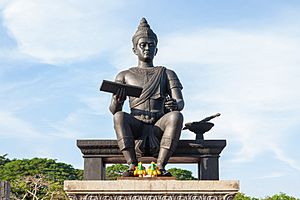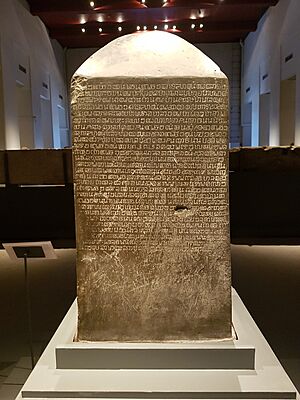Ram Khamhaeng facts for kids
Quick facts for kids Ram Khamhaeng the Greatพ่อขุนรามคำแหงมหาราช |
|
|---|---|
| Pho Khun Ram Khamhaeng maharat | |

Statue of King Ram Khamhaeng the Great, Sukhothai Historical Park, Sukhothai Province, Thailand
|
|
| Pho Khun of Sukhothai | |
| Reign | 1279 - 1298 |
| Predecessor | Ban Mueang |
| Successor | Loe Thai |
| Born | c. 1237/1247 Sukhothai Kingdom |
| Died | 1298 (51/61 years old) Sukhothai Kingdom |
| Issue | Loe Thai Phaya Sai Songkhram May Hnin Thwe-Da |
| House | Phra Ruang Dynasty |
| Father | Si Inthrathit |
| Mother | Sueang |
| Religion | Theravada Buddhism |
Ram Khamhaeng or Pho Khun Ram Khamhaeng Maharat was a powerful king of the Sukhothai Kingdom in Thailand. He was the third ruler of the Phra Ruang Dynasty. He ruled from 1279 to 1298, a time when his kingdom was very successful.
King Ram Khamhaeng is famous for two big achievements. He is believed to have created the Thai alphabet. He also made Theravada Buddhism the main religion of his kingdom.
Contents
Who Was King Ram Khamhaeng?
His Early Life and Family
Ram Khamhaeng was the son of King Si Inthrathit and Queen Sueang. His father was the first king of Sukhothai. Some old stories say his parents were actually an ogress and a fisherman!
He had two brothers and two sisters. His oldest brother passed away when he was very young. His second brother, Ban Mueang, became king after their father died. Ram Khamhaeng then became king after Ban Mueang passed away.
Becoming a Brave Prince
When Ram Khamhaeng was about 19 years old, he joined his father in a big battle. They successfully took over the city of Sukhothai. This battle made the Sukhothai Kingdom independent from the Khmer. Because he was so brave in this war, he was given the name "Rama the Bold."
After his father's death, his brother Ban Mueang ruled. Ram Khamhaeng was put in charge of the city of Si Satchanalai.
What Does His Name Mean?
Experts think Ram Khamhaeng's birth name was "Ram." This name comes from "Rama," a hero in an old Hindu story called the Ramayana. It was common back then to name a grandson after a grandfather. Ram Khamhaeng had a grandson named "Phraya Ram."
The name "Ramkhamhaeng" is just another way to spell his name in English. The word "Maharat" means "the Great King" in Thai.
When Did Ram Khamhaeng Become King?

A Thai historian named Tri Amattayakun believes Ram Khamhaeng became king in 1279. This was the year he planted a sugar palm tree in Sukhothai. Planting a tree on coronation day was a tradition for some kings. They hoped their rule would grow as strong as the tree.
An important event at the start of his reign involved one of his daughters, Lady Soidao. She ran away with a commoner who was a palace guard. This commoner later became a king in Burma and created a set of laws. These laws were used in Thailand for a long time.
What Did King Ram Khamhaeng Do?
Connecting with China
King Ram Khamhaeng sent special messengers to Yuan China many times. This was between 1282 and 1323. From China, he brought back the skills to make beautiful ceramics. These ceramics are now known as Sangkhalok ceramic ware.
Expanding the Kingdom
Some historians believe King Ram Khamhaeng greatly expanded his kingdom. It might have reached as far north as Lampang and Nan. To the east, it could have included Vientiane. In the south, it might have reached the Nakhon Si Thammarat Kingdom. To the west, it may have included parts of what is now Myanmar.
However, in those days, kingdoms didn't have clear borders like countries do today. Their power depended on how strong their capital city was. Claims of a very large kingdom were sometimes made to show how important the Siamese (Thai) people were in Southeast Asia.
Creating the Thai Alphabet
King Ram Khamhaeng is famous for creating the Thai alphabet. He developed it by combining parts of the Sanskrit, Pali, and Grantha alphabets. This was a huge step for the Thai language and culture.
How Did King Ram Khamhaeng Die?
According to Chinese records, King Ram Khamhaeng died in 1298. His son, Loe Thai, became the next king. Some legends say he disappeared in the fast-moving waters of a river. Another story suggests he was killed in battle by a Malay warrior princess.
King Ram Khamhaeng's Lasting Impact

The Ram Khamhaeng Inscription
Much of what we know about King Ram Khamhaeng comes from a special stone called the Ram Khamhaeng stele. This stone has writing carved into it from 1292. It tells us some facts about the king. You can see it today in the Bangkok National Museum. This important stone was added to the UNESCO Memory of the World Register in 2003.
Sangkhalok Ceramics
King Ram Khamhaeng is praised for bringing the art of making ceramics from China to Sukhothai. This helped create a strong ceramic industry in the kingdom. For hundreds of years, Sukhothai was a major exporter of "Sangkhalok ware." These ceramics were sent to countries like Japan, the Philippines, and Indonesia. This industry brought a lot of money to the kingdom.
Honoring His Memory
- Money Note: King Ram Khamhaeng is shown on the back of the 20 Baht note in Thailand. This note celebrates his invention of the Thai script.
- University: Ramkhamhaeng University is named after him. It's a large university in Thailand that allows many students to study.
- Video Games: King Ram Khamhaeng is even a playable leader in the video game Sid Meier's Civilization V. In the game, he helps the Siamese get more food and culture from other cities.
Images for kids
-
The three kings monument in Chiang Mai: King Ngam Muang of Phayao (left), King Mangrai of Lan Na (center), and King Ram Khamhaeng of Sukhothai (right).
-
Ramkhamhaeng stele, Bangkok National Museum
See also
 In Spanish: Ramkhamhaeng para niños
In Spanish: Ramkhamhaeng para niños




